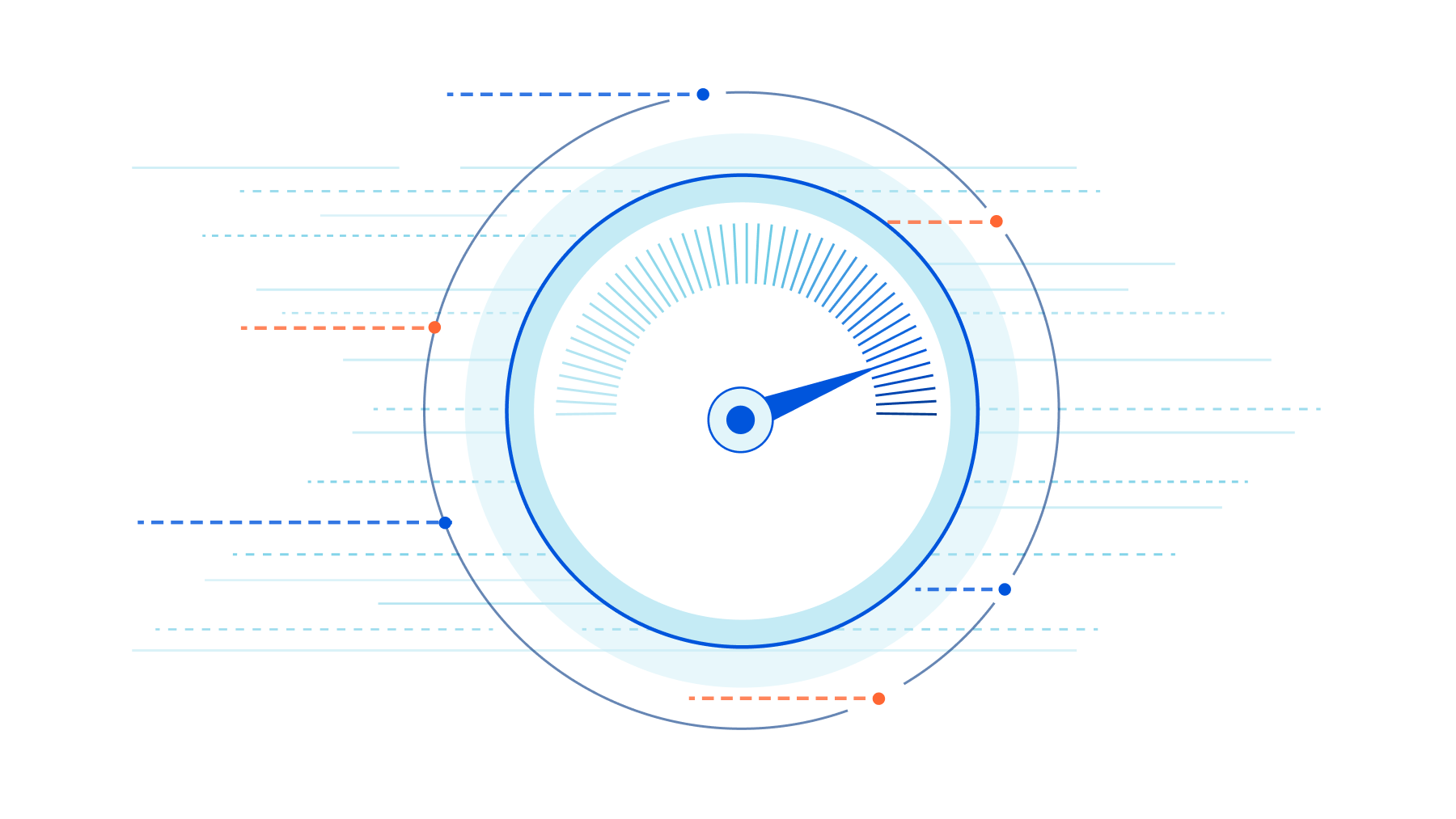Author Archives: David Tuber
Author Archives: David Tuber

We constantly measure our own network’s performance against other networks, look for ways to improve our performance compared to them, and share the results of our efforts. Since June 2021, we’ve been sharing benchmarking results we’ve run against other networks to see how we compare.
In this post we are going to share the most recent updates since our last post in September, and talk about how we are getting as fast as we are.
Since June 2021, we’ve been taking a close look at the most reported eyeball-facing ISPs and taking actions for the specific networks where we have some room for improvement. Cloudflare was already the fastest provider for TCP Connection time at the 95th percentile for 44% of the networks around the world (we define a network as country and AS number pair). We chose this metric to show how our network helps make your websites faster by getting you to where your customers are. Taking a look at the numbers, in July 2022, Cloudflare was ranked #1 in 33% of the networks and was within 2 ms (95th percentile TCP Connection Time) or 5% of the #1 provider for Continue reading


We constantly measure our own network’s performance against other networks, look for ways to improve our performance compared to them, and share the results of our efforts. Since June 2021, we’ve been sharing benchmarking results we’ve run against other networks to see how we compare.
In this post we are going to share the most recent updates since our last post in June, and tell you about our tools and processes that we use to monitor and improve our network performance.
Since June 2021, we’ve been taking a close look at every single network and taking actions for the specific networks where we have some room for improvement. Cloudflare was already the fastest provider for most of the networks around the world (we define a network as country and AS number pair). Taking a closer look at the numbers; in July 2022, Cloudflare was ranked #1 in 33% of the networks and was within 2 ms (95th percentile TCP Connection Time) or 5% of the #1 provider for 8% of the networks that we measured. For reference, our closest competitor on that front was the fastest for 20% of networks.
As of August 30, Continue reading


Picture this: you’re at an airport, and you’re going through an airport security checkpoint. There are a bunch of agents who are scanning your boarding pass and your passport and sending you through to your gate. All of a sudden, some of the agents go on break. Maybe there’s a leak in the ceiling above the checkpoint. Or perhaps a bunch of flights are leaving at 6pm, and a number of passengers turn up at once. Either way, this imbalance between localized supply and demand can cause huge lines and unhappy travelers — who just want to get through the line to get on their flight. How do airports handle this?
Some airports may not do anything and just let you suffer in a longer line. Some airports may offer fast-lanes through the checkpoints for a fee. But most airports will tell you to go to another security checkpoint a little farther away to ensure that you can get through to your gate as fast as possible. They may even have signs up telling you how long each line is, so you can make an easier decision when trying to get through.
At Cloudflare, we have the same problem. We Continue reading


Cloudflare has done several deep dives into Zero Trust performance in 2023 alone: one in January, one in March, and one for Speed Week. In each of them, we outline a series of tests we perform and then show that we’re the fastest. While some may think that this is a marketing stunt, it’s not: the tests we devised aren’t necessarily built to make us look the best, our network makes us look the best when we run the tests.
We’ve discussed why performance matters in our blogs before, but the short version is that poor performance is a threat vector: the last thing we want is for your users to turn off Zero Trust to get an experience that is usable for them. Our goal is to improve performance because it helps improve the security of your users, the security of the things that matter most to you, and enables your users to be more productive.
When we run Zero Trust performance tests, we start by measuring end-to-end latency from when a user sends a packet to when the Zero Trust proxy receives, forwards, and inspects the packet, to when the destination website processes the packet and Continue reading


In January and in March we posted blogs outlining how Cloudflare performed against others in Zero Trust. The conclusion in both cases was that Cloudflare was faster than Zscaler and Netskope in a variety of Zero Trust scenarios. For Speed Week, we’re bringing back these tests and upping the ante: we’re testing more providers against more public Internet endpoints in more regions than we have in the past.
For these tests, we tested three Zero Trust scenarios: Secure Web Gateway (SWG), Zero Trust Network Access (ZTNA), and Remote Browser Isolation (RBI). We tested against three competitors: Zscaler, Netskope, and Palo Alto Networks. We tested these scenarios from 12 regions around the world, up from the four we’d previously tested with. The results are that Cloudflare is the fastest Secure Web Gateway in 42% of testing scenarios, the most of any provider. Cloudflare is 46% faster than Zscaler, 56% faster than Netskope, and 10% faster than Palo Alto for ZTNA, and 64% faster than Zscaler for RBI scenarios.
In this blog, we’ll provide a refresher on why performance matters, do a deep dive on how we’re faster for each scenario, and we’ll talk about how we measured performance for each product.


For developers, performance is everything. If your app is slow, it will get outclassed and no one will use it. In order for your application to be fast, every underlying component and system needs to be as performant as possible. In the past, we’ve shown how our network helps make your apps faster, even in remote places. We’ve focused on how Workers provides the fastest compute, even in regions that are really far away from traditional cloud datacenters.
For Developer Week 2023, we’re going to be looking at one of the newest Cloudflare developer offerings and how it compares to an alternative when retrieving assets from buckets: R2 versus Amazon Simple Storage Service (S3). Spoiler alert: we’re faster than S3 when serving media content via public access. Our test showed that on average, Cloudflare R2 was 20-40% faster than Amazon S3. For this test, we used 95th percentile Response tests, which measures the time it takes for a user to make a request to the bucket, and get the entirety of the response. This test was designed with the goal of measuring end-user performance when accessing content in public buckets.
In this blog we’re going to talk about why your Continue reading


You’re visiting your family for the holidays and you connect to the WiFi, and then notice Netflix isn’t loading as fast as it normally does. You go to speed.cloudflare.com, fast.com, speedtest.net, or type “speed test” into Google Chrome to figure out if there is a problem with your Internet connection, and get something that looks like this:

If you want to see what that looks like for you, try it yourself here. But what do those numbers mean? How do those numbers relate to whether or not your Netflix isn’t loading or any of the other common use cases: playing games or audio/video chat with your friends and loved ones? Even network engineers find that speed tests are difficult to relate to the user experience of… using the Internet..
Amazingly, speed tests have barely changed in nearly two decades, even though the way we use the Internet has changed a lot. With so many more people on the Internet, the gaps between speed tests and the user’s experience of network quality are growing. The problem is so important that the Internet’s standards organization is paying attention, too.
From a high-level, there are three grand network Continue reading


During every Innovation Week, Cloudflare looks at our network’s performance versus our competitors. In past weeks, we’ve focused on how much faster we are compared to reverse proxies like Akamai, or platforms that sell serverless compute that compares to our Supercloud, like Fastly and AWS. This week, we’d like to provide an update on how we compare to other reverse proxies as well as an update to our application services security product comparison against Zscaler and Netskope. This product is part of our Zero Trust platform, which helps secure applications and Internet experiences out to the public Internet, as opposed to our reverse proxy which protects your websites from outside users.
In addition to our previous post showing how our Zero Trust platform compared against Zscaler, we also have previously shared extensive network benchmarking results for reverse proxies from 3,000 last mile networks around the world. It’s been a while since we’ve shown you our progress towards being #1 in every last mile network. We want to show that data as well as revisiting our series of tests comparing Cloudflare Access to Zscaler Private Access and Netskope Private Access. For our overall network tests, Cloudflare is #1 in Continue reading


Realizing the goals of Zero Trust is a journey: moving from a world of static networking and hardware concepts to organization-based access and continuous validation is not a one-step process. This challenge is never more real than when dealing with IP addresses. For years, companies on the Internet have built hardened systems based on the idea that only users with certain IP addresses can access certain resources. This implies that IP addresses are tied with identity, which is a kluge and can actually open websites up to attack in some cases. For large companies with many origins and applications that need to be protected in a Zero Trust model, it’s important to be able to support their transition to Zero Trust using mTLS, Access, or Tunnel. To make the transition some organizations may need dedicated IP addresses.
Today we’re introducing Cloudflare Aegis: dedicated IPs that we use to send you traffic. This allows you to lock down your services and applications at an IP level and build a protected environment that is application aware, protocol aware, and even IP-aware. Aegis is available today through Early Access for Enterprise customers, and you can talk to your account team if you want Continue reading


We are thrilled to introduce an innovative new approach to secure hosted applications via Cloudflare Access without the need for any installed software or custom code on your application server. But before we dive into how this is possible, let's review why Access previously required installed software or custom code on your application server.
Traditionally, companies used a Virtual Private Network (VPN) to access a hosted application, where all they had to do was configure an IP allowlist rule for the VPN. However, this is a major security threat because anyone on the VPN can access the application, including unauthorized users or attackers.
We built Cloudflare Access to replace VPNs and provide the option to enforce Zero Trust policies in hosted applications. Access allows you to verify a user's identity before they even reach the application. By acting as a proxy in front of your application's hostname (e.g. app.example.com), Cloudflare enables strong verification techniques such as identity, device posture, hardkey MFA, and more. All without having to directly add SSO or Authentication logic directly into your applications.
However, since Access enforces at a hostname level, there is still a potential Continue reading

This post is also available in 简体中文, 日本語 and Español.

For CIOs, networking is a hard process that is often made harder. Corporate networks have so many things that need to be connected and each one of them needs to be connected differently: user devices need managed connectivity through a Secure Web Gateway, offices need to be connected using the public Internet or dedicated connectivity, data centers need to be managed with their own private or public connectivity, and then you have to manage cloud connectivity on top of it all! It can be exasperating to manage connectivity for all these different scenarios and all their privacy and compliance requirements when all you want to do is enable your users to access their resources privately, securely, and in a non-intrusive manner.
Cloudflare helps simplify your connectivity story with Cloudflare One. Today, we’re excited to announce that we support direct cloud interconnection with our Cloudflare Network Interconnect, allowing Cloudflare to be your one-stop shop for all your interconnection needs.
Customers using IBM Cloud, Google Cloud, Azure, Oracle Cloud Infrastructure, and Amazon Web Services can now open direct connections from their private cloud instances into Cloudflare. In this blog, we’re going Continue reading


Every Innovation Week, Cloudflare looks at our network’s performance versus our competitors. In past weeks, we’ve focused on how much faster we are compared to reverse proxies like Akamai, or platforms that sell edge compute that compares to our Supercloud, like Fastly and AWS. For CIO Week, we want to show you how our network stacks up against competitors that offer forward proxy services. These products are part of our Zero Trust platform, which helps secure applications and Internet experiences out to the public Internet, as opposed to our reverse proxy which protects your websites from outside users.
We’ve run a series of tests comparing our Zero Trust services with Zscaler. We’ve compared our ZT Application protection product Cloudflare Access against Zscaler Private Access (ZPA). We’ve compared our Secure Web Gateway, Cloudflare Gateway, against Zscaler Internet Access (ZIA), and finally our Remote Browser Isolation product, Cloudflare Browser Isolation, against Zscaler Cloud Browser Isolation. We’ve found that Cloudflare Gateway is 58% faster than ZIA in our tests, Cloudflare Access is 38% faster than ZPA worldwide, and Cloudflare Browser Isolation is 45% faster than Zscaler Cloud Browser Isolation worldwide. For each of these tests, we used 95th percentile Time to First Byte Continue reading


One of the many magical things about the Internet is that it doesn’t have a country. The Internet doesn’t go through customs, it doesn’t need a visa, and it doesn’t speak any one language. To reach the world’s greatest information innovation, a user – no matter what country they’re in – only needs a device with a connection. The Internet will take care of the rest. At Cloudflare, part of our role is to make sure every person on the planet with an Internet connection has a good experience, whether they’re in a next-generation market or a current-gen market. In this blog we’re going to talk about how we define next-generation markets, how we help people in these markets get faster access to the websites and applications they use on a daily basis, and how we make it easy for developers to deploy services geographically close to users in next-generation markets.
Next-generation markets are the future of the Internet. Not only are there billions of people who will use the Internet more, as affordable access increases, but the trends in application development already point towards the mobile-first, sometimes mobile-only, way of providing content and services. The Continue reading


Cloudflare is building the fastest network in the world. But we don’t want you to just take our word for it. To demonstrate it, we are continuously testing ourselves versus everyone else to make sure we’re the fastest. Since it’s Developer Week, we wanted to provide an update on how our Workers products perform against the competition, as well as our overall network performance.
Earlier this year, we compared ourselves to Fastly’s Compute@Edge and overall we were faster. This time, not only did we repeat the tests, but we also added AWS Lambda@Edge to help show how we stack up against more and more competitors. The summary: we offer the fastest developer platform on the market. Let’s talk about how we build our network to help make you faster, and then we’ll get into how that translates to our developer platform.
We have two updates on data: a general network performance update, and then data on how Workers compares with Compute@Edge and Lambda@Edge.
To quantify global network performance, we have to get enough data from around the world, across all manner of different networks, comparing ourselves with other providers. We used Real User Measurements (RUM) Continue reading


In 2018, we launched the Cloudflare Peering Portal, which allows network operators to see where your traffic is coming from and to identify the best possible places to interconnect with Cloudflare. We’re excited to announce that we’ve made it even easier to interconnect with Cloudflare through this portal by removing Cloudflare-specific logins and allowing users to request sessions in the portal itself!
We’re going to walk through the changes we’ve made to make peering easier, but before we do that, let’s talk a little about peering: what it is, why it’s important, and how Cloudflare is making peering easier.
Put succinctly, peering is the act of connecting two networks together. If networks are like towns, peering is the bridges, highways, and streets that connect the networks together. There are lots of different ways to connect networks together, but when networks connect, traffic between them flows to their destination faster. The reason for this is that peering reduces the number of Border Gateway Protocol (BGP) hops between networks.
For a quick refresher, Border Gateway Protocol (or BGP for short) is a protocol that propagates instructions on how networks should Continue reading


In September 2021, we shared extensive benchmarking results of 1,000 networks all around the world. The results showed that on a range of tests (TCP connection time, time to first byte, time to last byte), and on different measures (p95, mean), Cloudflare was the fastest provider in 49% of the top 1,000 networks around the world.
Since then, we’ve expanded our testing to cover not just 1,000 but 3,000 networks, and we’ve worked to continuously improve performance, with the ultimate goal of being the fastest everywhere and an intermediate goal to grow the number of networks where we’re the fastest by at least 10% every Innovation Week. We met that goal Platform Week May 2022), and we’re carrying the work over to Cloudflare One Week (June 2022).
We’re excited to share that Cloudflare was the fastest provider in 1,290 of the top 3,000 most reported networks, up from 1,280 even one month ago during Platform Week.
To quantify global network performance, we have to get enough data from around the world, across all manner of different networks, comparing ourselves with other providers. We use Real User Measurements (RUM) to fetch a 100kB file from different providers. Continue reading

In September 2021, we shared extensive benchmarking results of 1,000 networks all around the world. The results showed that on a range of tests (TCP connection time, time to first byte, time to last byte), and on different measures (p95, mean), Cloudflare was the fastest provider in 49% of networks around the world. Since then, we’ve worked to continuously improve performance, with the ultimate goal of being the fastest everywhere and an intermediate goal to grow the number of networks where we’re the fastest by at least 10% every Innovation Week. We met that goal during Security Week (March 2022), and we’re carrying the work over to Platform Week (May 2022).
We’re excited to update you on the latest results, but before we do: after running with this benchmark for nine months, we've also been looking for ways to improve the benchmark itself — to make it even more representative of speeds in the real world. To that end, we're expanding our measured networks from 1,000 to 3,000, to give an even more accurate sense of real world performance across the globe.
In terms of results: using the old benchmark of 1,000 networks, we’re the fastest in 69% of them. Continue reading


As part of the recently passed Infrastructure Investment and Jobs Act (Infrastructure Act) in the United States, Congress asked the Federal Communications Commission (FCC) to finalize rules that would require broadband Internet access service providers (ISPs) display a “label” that provides consumers with a simple layout that discloses prices, introductory rates, data allowances, broadband performance, management practices, and more.

While the idea of a label is not new (the original design dates from 2016), its inclusion in the Infrastructure Act has reinvigorated the effort to provide consumers with information sufficient to enable them to make informed choices when purchasing broadband service. The FCC invited the public to submit comments on the existing label, and explain how the Internet has changed since 2016. We’re sharing Cloudflare’s comments here as well to call attention to this opportunity to make essential information accessible, accurate, and transparent to the consumer. We encourage you to read our full comments. (All comments, from Cloudflare and others, are available for public consumption on the FCC website.)
Six years can change a lot of things, and the Internet is Continue reading


Almost a year ago, we shared extensive benchmarking results of last mile networks all around the world. The results showed that on a range of tests (TCP connection time, time to first byte, time to last byte), and on different measures (p95, mean), Cloudflare was the fastest provider in 49% of networks around the world. Since then, we’ve worked to continuously improve performance towards the ultimate goal of being the fastest everywhere. We set a goal to grow the number of networks where we’re the fastest by 10% every Innovation Week. We met that goal last year, and we’re carrying the work over to 2022.
Today, we’re proud to report we are the fastest provider in 71% of the top 1,000 most reported networks around the world. Of course, we’re not done yet, but we wanted to share the latest results and explain how we did it.
To quantify network performance, we have to get enough data from around the world, across all manner of different networks, comparing ourselves with other providers. We used Real User Measurements (RUM) to fetch a 100kb file from several different providers. Users around the world report the performance of different providers. Continue reading


Building a corporate network is hard. We want to enable IT teams to focus on exploring and deploying cutting edge technologies to make employees happier and more productive — not figuring out how to add 100 Mbps of capacity on the third floor of a branch office building.
And yet, as we speak to CIOs and IT teams, we consistently hear of the challenge required to manage organization connectivity. Today, we’re sharing more about how we’re solving connectivity challenges for CIOs and IT teams. There are three parts to our approach: we’re making our network more valuable in terms of the benefit you get from connecting to us; we’re expanding our reach, so we can offer connectivity in more places; and we’re further reducing our provisioning times, so there’s no more need to plan six months in advance.
Cloudflare delivers security, reliability, and performance products as a service, all from our global network. We’ve spent the past week talking about new releases and enhanced functionality — if you haven’t yet, please check out some exciting posts on how to replace your hardware firewall, managing third party tools in the cloud, and protecting your web pages Continue reading